UP TO THE MINUTE
Cool city, cool people and cool surfaces
June 26, 2025 at 9:00 a.m.By Lauren White.
There’s no voodoo involved when talking about cool surfaces at the CRRC Annual Meeting.
Between ghost tours, vampire apothecaries and beignets, the Big Easy hosted the Cool Roof Rating Council (CRRC) annual meeting. From June 10-12, 2025, members of the CRRC, committee members, sponsors and interested individuals ventured south to New Orleans, Louisiana to talk about Cool Surfaces in Action.
Day 1 - Committee meeting day
After breakfast, handshakes and hello’s, the technical committee kicked off the day with roll call, minute approvals and proposed revisions and changes. George Daisy with DOW and the chair of the CRRC technical committee; Sarah Schneider, CRRC deputy director; and Stacey Weister, CRRC senior technical manager presented throughout the morning.
About 40 people in person and a handful via Zoom convened for the first half of the day making decisions about definition edits and procedural changes to five-point reflectance test updates and insights on the program manual digitization project.
 After the lunch break, the educational committee meeting started both in person and via Zoom for those who couldn’t travel this week. Kurt Shickman, an interested individual and the educational committee chair; Audrey McGarrell, CRRC communications manager; and Iona Isachsen, Smart Surfaces Coalition shared:
After the lunch break, the educational committee meeting started both in person and via Zoom for those who couldn’t travel this week. Kurt Shickman, an interested individual and the educational committee chair; Audrey McGarrell, CRRC communications manager; and Iona Isachsen, Smart Surfaces Coalition shared:
- Project updates and timelines for completion
- Downloads and resources information
- Cool surfaces lesson plan status update
At the end of the day, the floor opened up for anyone to talk about new business, ask questions and for updates on ongoing projects and discuss future priorities and projects.
Day 2 - Annual meeting time
 This year, about 70 people, ranging from roofing contractors and interested individuals to manufacturers and research and academic professionals, convened to hear updates, ask questions and learn about new initiatives happening across the nation.
This year, about 70 people, ranging from roofing contractors and interested individuals to manufacturers and research and academic professionals, convened to hear updates, ask questions and learn about new initiatives happening across the nation.
Sponsors for the event include: Ace Laboratories as a platinum sponsor; Duro-Last, 3M, Climate Reserve, PRI, MACOMA as gold sponsors; IKO, DOW, Atlas, Siplast, Westlake Royal Roofing Solutions, RoofersCoffeeShop® as silver sponsors; Topps Products and R&D Services as bronze sponsors.
Attendees represented a range of professionals from state energy offices, laboratories, distributors, codes and compliance divisions and universities. Some companies in attendance included: Sherwin-Williams, General Coatings, Western Colloid, Polyglass, 3M, ACE Laboratories, Hawaii State Energy Office, National Roofing Contractors Association (NRCA), CertainTeed, National Coil Coatings Association, among others.
A common theme throughout updates and presentations during the day was expanding reach and education. The CRRC continues to grow and while most members are located in the United States, there are now members in India and Australia. They also continue to broaden their reach through podcasts and webinars, speaking and showcasing at trade shows, publishing new resources, building up their social media – go follow them on LinkedIn, Instagram and Threads – and more! The morning was full of committee information and updates.
Looking ahead, their goals are to continue to educate building contractors, increase code and program references, make cool surface research more accessible, and also improve and grow existing rating programs.
Marty Hastings Award
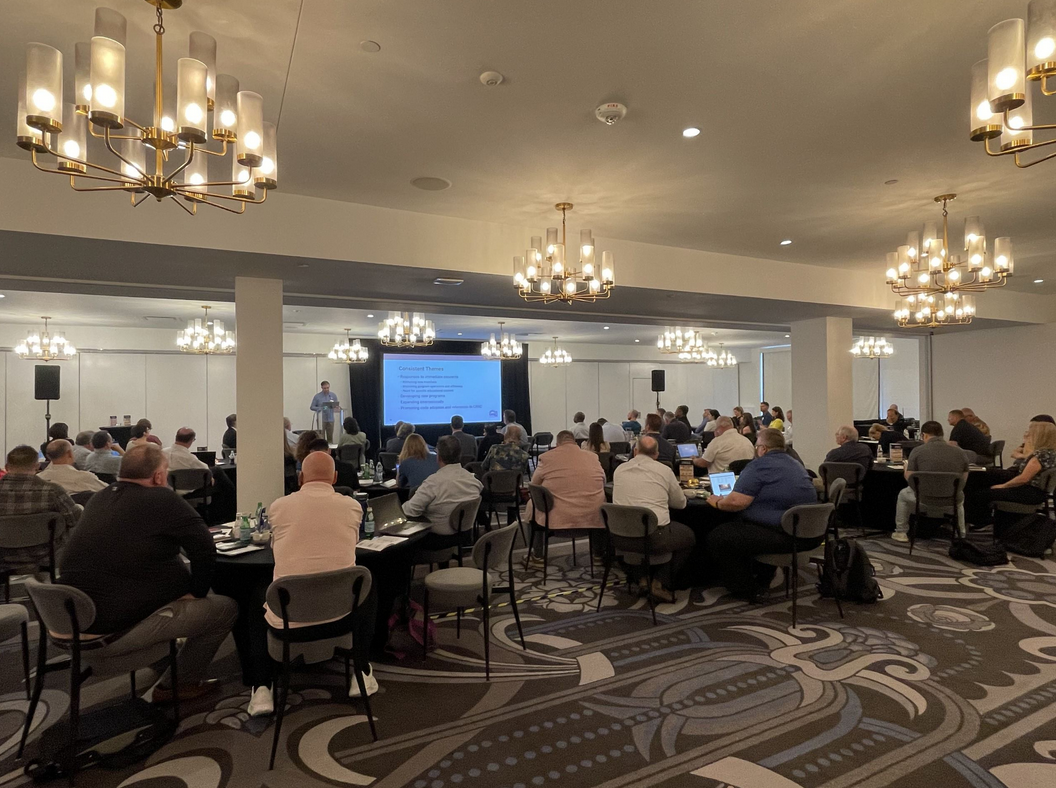 The 2025 recipient of the Marty Hastings Award is Kurt Shickman who has been a member of the CRRC for over a decade and has held multiple leadership roles throughout the years. The Marty Hastings Award was started in 2011 to honor Marty Hastings, a longtime CRRC board member and contributor. The recipient of this award is someone who makes great contributions to the CRRC and their efforts. In addition to the award, a monetary donation is made to a charity of the recipient’s choice. Kurt chose to donate to the Environmental and Energy Study Institute (EESI), Future Climate Leaders Scholarship. The EESI is a nonprofit offering science-based education to policymakers and the public, aiming to build a sustainable, resilient future through solutions to climate, energy and environmental challenges. This donation will go to fund scholarships and other academic support programs for students at historically black colleges.
The 2025 recipient of the Marty Hastings Award is Kurt Shickman who has been a member of the CRRC for over a decade and has held multiple leadership roles throughout the years. The Marty Hastings Award was started in 2011 to honor Marty Hastings, a longtime CRRC board member and contributor. The recipient of this award is someone who makes great contributions to the CRRC and their efforts. In addition to the award, a monetary donation is made to a charity of the recipient’s choice. Kurt chose to donate to the Environmental and Energy Study Institute (EESI), Future Climate Leaders Scholarship. The EESI is a nonprofit offering science-based education to policymakers and the public, aiming to build a sustainable, resilient future through solutions to climate, energy and environmental challenges. This donation will go to fund scholarships and other academic support programs for students at historically black colleges.
Cool guest presentations about cool surfaces
Adopting cool roofs in historically cool climates
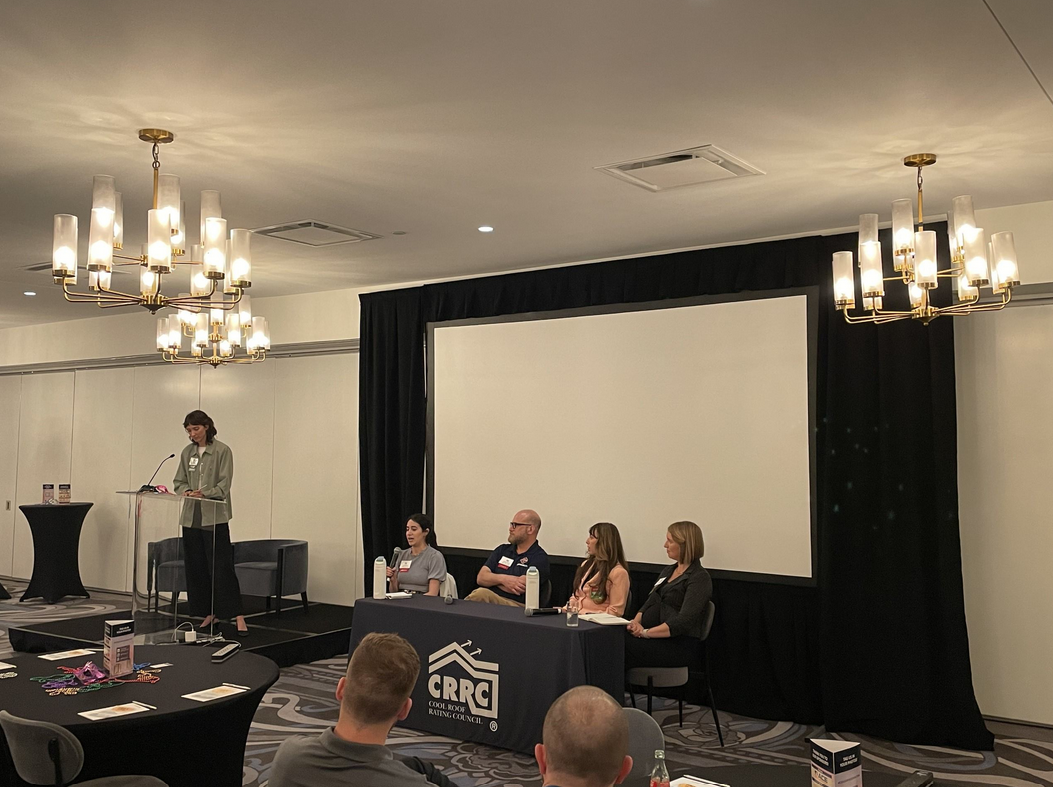 Julia Nassar, senior energy and climate planner for The Metropolitan Area Planning Council (MAPC) for Greater Boston shared about “Expanding Cool Roof Awareness and Adoption in Metro-Boston.” MAPC is a regional planning agency serving the people who live and work in the 101 cities and towns of the Metropolitan Boston region. According to Julia, the frequency and severity of extreme heat events in historically cooler regions like New England where aging housing stock, low AC prevalence and limited heat-risk awareness leaves residents ill-prepared. MAPC’s Cool Roofs Initiative is a project aimed at expanding the awareness and adoption of cool roofs to help reduce heat and energy demand. Their goal is to promote the adoption of cools roofs in the Metro Mayors (16 cities making up the inner core of Boston) region through developing support tools and resources.
Julia Nassar, senior energy and climate planner for The Metropolitan Area Planning Council (MAPC) for Greater Boston shared about “Expanding Cool Roof Awareness and Adoption in Metro-Boston.” MAPC is a regional planning agency serving the people who live and work in the 101 cities and towns of the Metropolitan Boston region. According to Julia, the frequency and severity of extreme heat events in historically cooler regions like New England where aging housing stock, low AC prevalence and limited heat-risk awareness leaves residents ill-prepared. MAPC’s Cool Roofs Initiative is a project aimed at expanding the awareness and adoption of cool roofs to help reduce heat and energy demand. Their goal is to promote the adoption of cools roofs in the Metro Mayors (16 cities making up the inner core of Boston) region through developing support tools and resources.
Through the Cool Roof’s Initiative, they developed tools and resources to raise awareness among building owners, contractors and policymakers in Metro-Boston. Julia shared a variety of resources available, including:
- Cool roof self-assessment: 11 question assessment to help people determine if a cool roof is right for a property
- Cool roof suitability tool – Interactive map that allows users to identify opportunities for cool roof retrofits.
- An Educational Toolkit that’s translated into five different languages
- Market analysis of cool roof potential
Data and climate action and heat mitigation
Douglas Melnick, chief sustainability officer for the city of San Antonio, about heat mitigation efforts and ongoing research efforts in San Antonio. As the sixth largest city in the U.S. with 17% of the population identified as low income, rising temperatures are affecting more people, costing more and having major negative impacts. San Antonio saw a record high of 117 degrees Fahrenheit in 2024! According to Douglas, “Extreme heat is here and it’s only going to continue to get more severe as we see an increase in temperatures because of human-caused climate change.”
During his presentation, “SA Climate Ready and Cool Neighborhoods: A Data-driven Approach to Climate Action and Heat Mitigation,” Douglas shared about the Urban Heat Mitigation Program that the City of San Antonio launched in 2024. Following an extensive mapping process, the City’s Office of Sustainability launched a Cool Neighborhood Program in four target areas to concentrate layered heat mitigation activities in conjunction with ongoing research. Based on the research, 73% of people shared that they were interested in cooler roofs as a strategy to mitigate heat. When cool roofs were installed on homes there was a significant 7.3% energy use reduction and a 10.1-degree reduction. The Cool Pavement Program started in 2023 and as of this year they’re on track to install 22.35 miles of cool pavement. Possible materials being tested are: GAF Streetbond – Durashield, SealMaster – SolarPave, GuardTop – Iron.
Albedo management
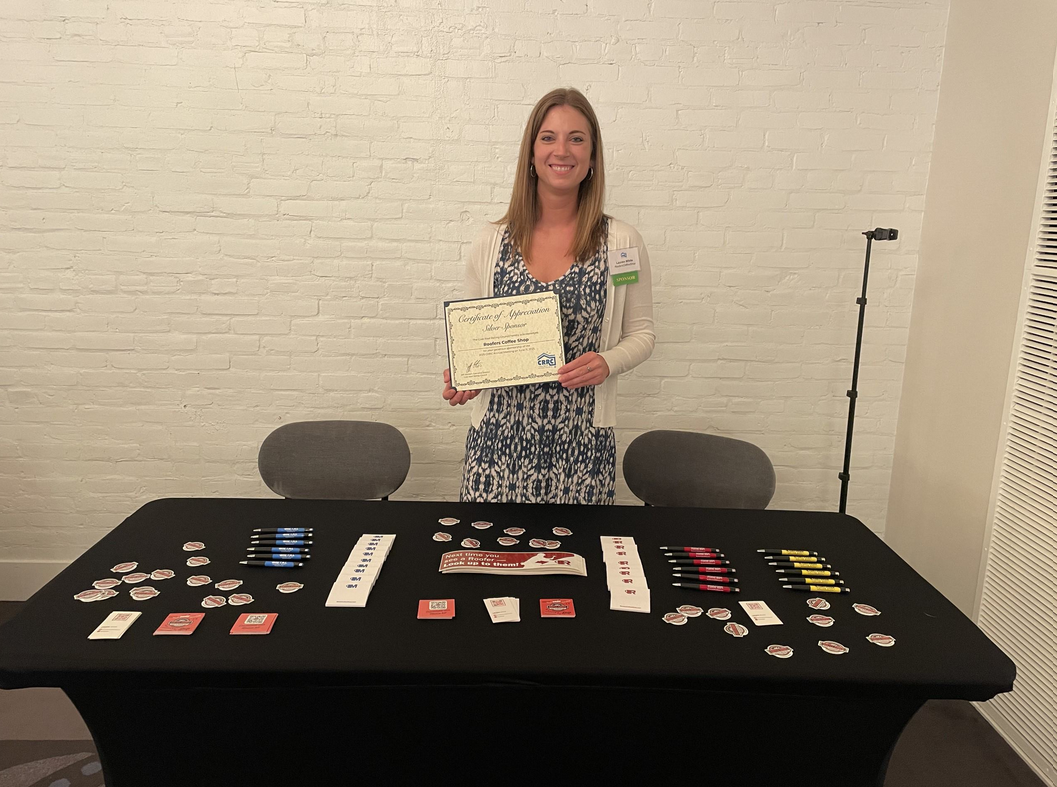 I learned a new term during this presentation: albedo. Albedo is the Latin word for “whiteness” or “lightness” and is the measure of how reflective a surface is. “Shine On: Recognizing Local and Global Benefits of Albedo Management” was presented by members from Climate Resolve. Bryn Moncelsi, deputy director, and Selena Melgoza, senior climate solutions analyst shared details about the Shine On Initiative, which was launched to recognize the full range of benefits of cool surfaces to spur broader deployment. A nonprofit based in Los Angeles, California, Climate Resolve’s mission is to champion equitable climate solutions. As of January 2015, Climate Resolve passed LA’s Cool Roof Ordinance and Rebate requiring all new and replacement roofs to be a cool roof. They were the first major city to establish a cool roof ordinance, and 10 years later, over 18 million square feet of cool roofing materials have been installed.
I learned a new term during this presentation: albedo. Albedo is the Latin word for “whiteness” or “lightness” and is the measure of how reflective a surface is. “Shine On: Recognizing Local and Global Benefits of Albedo Management” was presented by members from Climate Resolve. Bryn Moncelsi, deputy director, and Selena Melgoza, senior climate solutions analyst shared details about the Shine On Initiative, which was launched to recognize the full range of benefits of cool surfaces to spur broader deployment. A nonprofit based in Los Angeles, California, Climate Resolve’s mission is to champion equitable climate solutions. As of January 2015, Climate Resolve passed LA’s Cool Roof Ordinance and Rebate requiring all new and replacement roofs to be a cool roof. They were the first major city to establish a cool roof ordinance, and 10 years later, over 18 million square feet of cool roofing materials have been installed.
While cool streets are still in the pilot phase, they continue to work with the community and industry partners to reach widespread adoption. According to Climate Resolve, 40% of asphalt cover radiates heat all day and night, making it crucial to cool these surfaces not only for people accessing the streets but also to curb the urban heat island effect. As part of their pilot they have installed cool materials in a variety of city blocks, outdoor basketball courts and have seen a heat differential as high as 12 degrees Fahrenheit. While it’s still gaining traction, to date there have been 182 lane miles installed and they’re looking forward to more adoption and installation in the future.
This is my second year attending the CRRC Annual Meeting, and I learned just as much this year as I did last year in Las Vegas! It’s pretty incredible to be in the same room as other like-minded people from around the world who are working towards a more sustainable future. We write a lot on The Coffee Shops about sustainability and green initiatives, and the work the CRRC is doing is vitally important. I continue to be impressed with the brilliant minds who are helping the world stay cool.
Learn more about Cool Roof Rating Council (CRRC) in their Coffee Shop Directory or visit www.coolroofs.org.
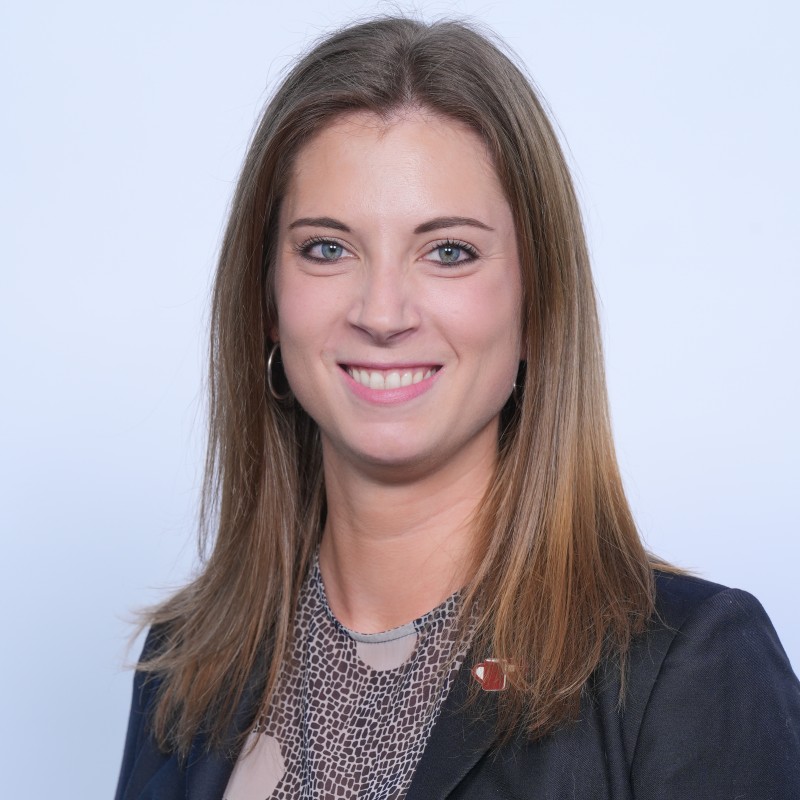
About Lauren
Lauren is the editor for RoofersCoffeeShop®, MetalCoffeeShop™ and AskARoofer™. When she’s not writing or reading articles, she's adventuring with her puppy Kira and trying new recipes.

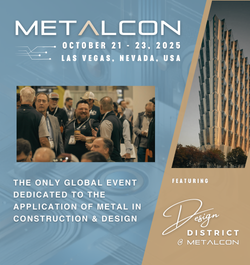

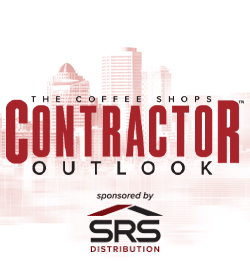
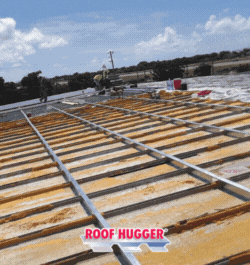
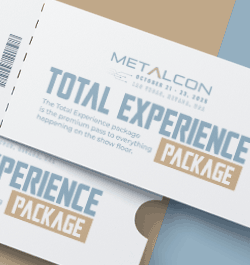

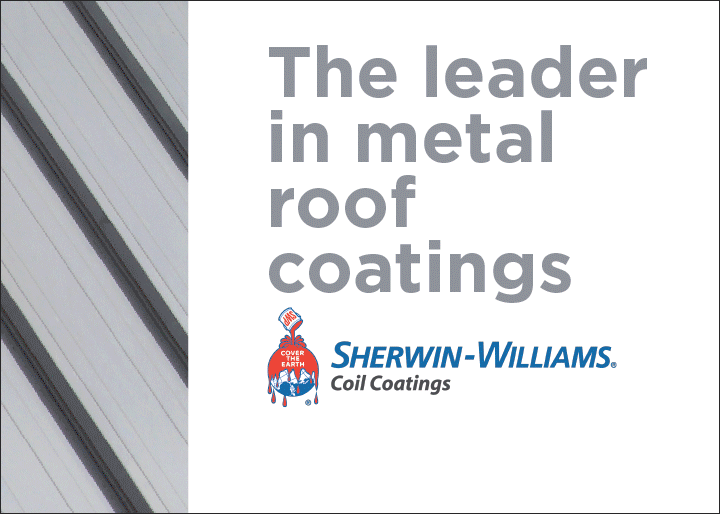
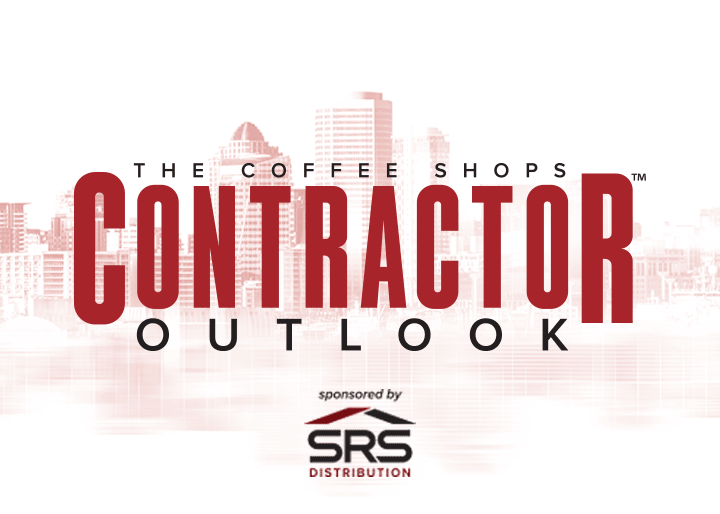


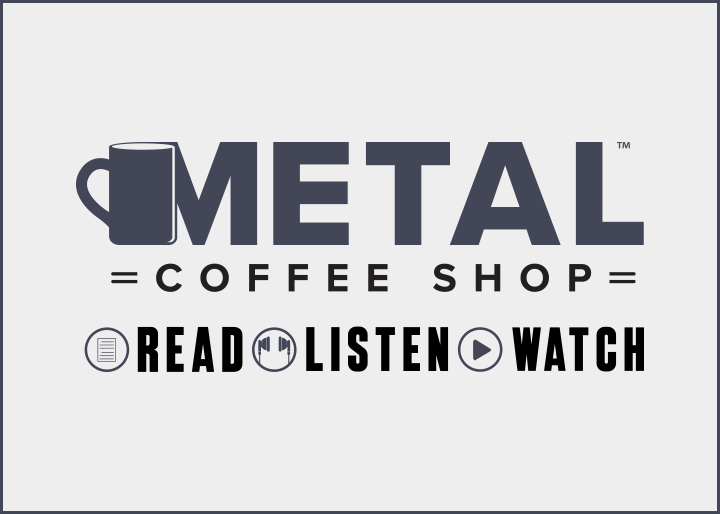
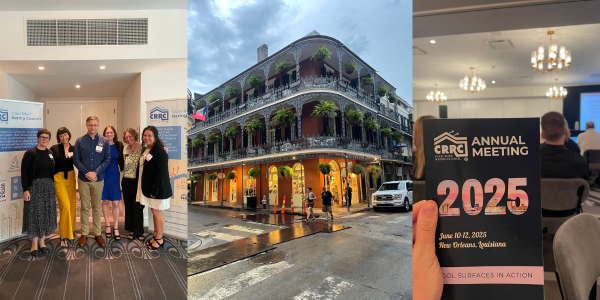
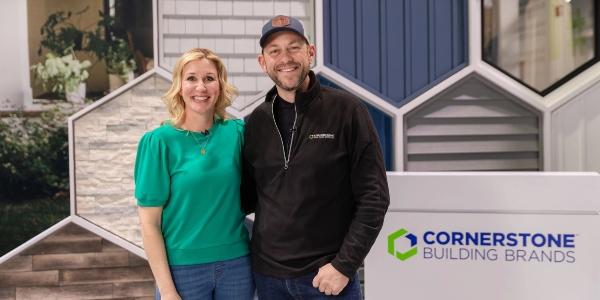
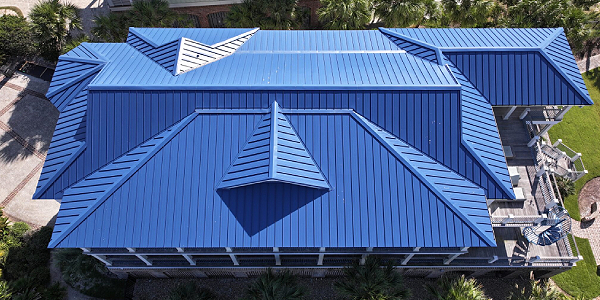





Comments
Leave a Reply
Have an account? Login to leave a comment!
Sign In